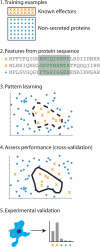Computational prediction of type III and IV secreted effectors in gram-negative bacteria
- PMID: 20974833
- PMCID: PMC3019878
- DOI: 10.1128/IAI.00537-10
Computational prediction of type III and IV secreted effectors in gram-negative bacteria
Abstract
In this review, we provide an overview of the methods employed in four recent studies that described novel methods for computational prediction of secreted effectors from type III and IV secretion systems in Gram-negative bacteria. We present the results of these studies in terms of performance at accurately predicting secreted effectors and similarities found between secretion signals that may reflect biologically relevant features for recognition. We discuss the Web-based tools for secreted effector prediction described in these studies and announce the availability of our tool, the SIEVE server (http://www.sysbep.org/sieve). Finally, we assess the accuracies of the three type III effector prediction methods on a small set of proteins not known prior to the development of these tools that we recently discovered and validated using both experimental and computational approaches. Our comparison shows that all methods use similar approaches and, in general, arrive at similar conclusions. We discuss the possibility of an order-dependent motif in the secretion signal, which was a point of disagreement in the studies. Our results show that there may be classes of effectors in which the signal has a loosely defined motif and others in which secretion is dependent only on compositional biases. Computational prediction of secreted effectors from protein sequences represents an important step toward better understanding the interaction between pathogens and hosts.
Figures

Similar articles
-
Computational prediction of type III secreted proteins from gram-negative bacteria.BMC Bioinformatics. 2010 Jan 18;11 Suppl 1(Suppl 1):S47. doi: 10.1186/1471-2105-11-S1-S47. BMC Bioinformatics. 2010. PMID: 20122221 Free PMC article.
-
Accurate prediction of secreted substrates and identification of a conserved putative secretion signal for type III secretion systems.PLoS Pathog. 2009 Apr;5(4):e1000375. doi: 10.1371/journal.ppat.1000375. Epub 2009 Apr 24. PLoS Pathog. 2009. PMID: 19390620 Free PMC article.
-
Sequence-based prediction of type III secreted proteins.PLoS Pathog. 2009 Apr;5(4):e1000376. doi: 10.1371/journal.ppat.1000376. Epub 2009 Apr 24. PLoS Pathog. 2009. PMID: 19390696 Free PMC article.
-
Features and algorithms: facilitating investigation of secreted effectors in Gram-negative bacteria.Trends Microbiol. 2023 Nov;31(11):1162-1178. doi: 10.1016/j.tim.2023.05.011. Epub 2023 Jun 20. Trends Microbiol. 2023. PMID: 37349207 Review.
-
Type VI Secretion Effectors: Methodologies and Biology.Front Cell Infect Microbiol. 2017 Jun 15;7:254. doi: 10.3389/fcimb.2017.00254. eCollection 2017. Front Cell Infect Microbiol. 2017. PMID: 28664151 Free PMC article. Review.
Cited by
-
Learning virulent proteins from integrated query networks.BMC Bioinformatics. 2012 Dec 2;13:321. doi: 10.1186/1471-2105-13-321. BMC Bioinformatics. 2012. PMID: 23198735 Free PMC article.
-
Novel type III effectors in Pseudomonas aeruginosa.mBio. 2015 Mar 17;6(2):e00161. doi: 10.1128/mBio.00161-15. mBio. 2015. PMID: 25784698 Free PMC article.
-
Using an optimal set of features with a machine learning-based approach to predict effector proteins for Legionella pneumophila.PLoS One. 2019 Jan 25;14(1):e0202312. doi: 10.1371/journal.pone.0202312. eCollection 2019. PLoS One. 2019. PMID: 30682021 Free PMC article.
-
Protein Sorting Prediction.Methods Mol Biol. 2024;2715:27-63. doi: 10.1007/978-1-0716-3445-5_2. Methods Mol Biol. 2024. PMID: 37930519
-
Genus-optimized strategy for the identification of chlamydial type III secretion substrates.Pathog Dis. 2013 Dec;69(3):213-22. doi: 10.1111/2049-632X.12070. Epub 2013 Aug 14. Pathog Dis. 2013. PMID: 23873765 Free PMC article.
References
-
- Akeda, Y., and J. E. Galan. 2005. Chaperone release and unfolding of substrates in type III secretion. Nature 437:911-915. - PubMed
-
- Amor, J. C., J. Swails, X. Zhu, C. R. Roy, H. Nagai, A. Ingmundson, X. Cheng, and R. A. Kahn. 2005. The structure of RalF, an ADP-ribosylation factor guanine nucleotide exchange factor from Legionella pneumophila, reveals the presence of a cap over the active site. J. Biol. Chem. 280:1392-1400. - PubMed
-
- Anderson, D. M., and O. Schneewind. 1997. A mRNA signal for the type III secretion of Yop proteins by Yersinia enterocolitica. Science 278:1140-1143. - PubMed
-
- Bailey, L., A. Gylfe, C. Sundin, S. Muschiol, M. Elofsson, P. Nordstrom, B. Henriques-Normark, R. Lugert, A. Waldenstrom, H. Wolf-Watz, and S. Bergstrom. 2007. Small molecule inhibitors of type III secretion in Yersinia block the Chlamydia pneumoniae infection cycle. FEBS Lett. 581:587-595. - PubMed
Publication types
MeSH terms
Substances
Grants and funding
LinkOut - more resources
Full Text Sources

